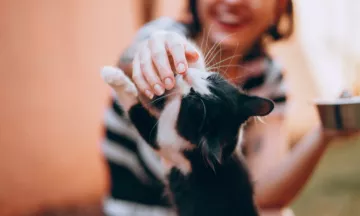It is a risk is always at in the back of your mind: what if your dog or cat goes missing? This is especially so if you plan to bring your pet to a sitter for home boarding or doggy daycare. You may worry about what happens if your furry friend suddenly takes off? Fortunately, most pets are found and returned to their owner very quickly. And the good news is that you can do a lot to prevent your pet from getting lost in the first place. And what if your pet does get lost? We have an action plan ready for you to bring your pet home quickly. Here are our most important tips for pet owners and pet sitters how to find a lost dog quickly.
Pictures and a description
We think we know our pet like the back of our hand, but if your dog or cat is gone missing, some doubts may start to arise: was that one black spot on his right or left ear? If your pet is lost, it is important to have a comprehensive, written description of your pet at hand as well as a couple of clear pictures. So, take photos of your pet and write down that description today and keep it with your important documents such as your pet passport and the contact details of your vet. This way, you also have a handy package ready for your pet sitter when you decide to go on a trip.
Microchip and registration
Especially when you want to bring your pet to a sitter for home dog boarding or doggy daycare, it's important that your pet has an up-to-date microchip.
Has your animal been microchipped? You should receive a certificate of it if all goes well. Veterinarians also put the chip number in the passport of your pet. Pets that are chipped are far more likely to be safely returned to their home when they get lost. That is why it is important not only to chip your pet, but also to ensure that the data in the database is still correct. So when anything change (for instance when you move to a new place), make sure to update your registration.
Collar Tag
In addition to a chip, it's clever and easy to attach an old-fashioned dog or cat collar tag to your pet's collar. You can order such a tag for just a few dollars on the internet. Make sure that the tag contauns at least the name of your pet and your phone number (on which you can always be reached). With such a simple tag, animals are often reunited with their owners very quickly - even before any authorities need to be notified.
A GPS tracker
Super handy for notorious runaways: a GPS tracker. With a tracker you can follow your pet anywhere with your smartphone. This is also a great (temporary) measure that offers you extra peace of mind if your pet stays with a dog sitter. Next to the tracker itself, keep in mind subscription costs of the tracker. Read more about GPS trackers here.

Preventing your pet from getting lost
First of all, it is important to invest time and energy by training your dog: build the relationship between you and your dog and make sure it's always FUN for your dog to return to you. Even if the dog has been gone for long, always praise him and give him treats when he comes back to you. But what if you have a 'runner': these are dogs that like to go hunting and tend to be out of sight for quite some time time during a walk. Don't let the dog run off-leash unless you are in a safe area where you have great visibility, such as the beach or a fenced dog park. As a dog sitter, it's better be safe than sorry and keep the dog on a leash, or you can use a flex line or long line so that the dog has enough freedom of movement.
Many pets tend to run away due to stress or changing circumstances. Your dog or cat might be a bit confused when he is in a new environment, for instance when you will be boarding your dog. That is why it is important to take enough time to introduce a new person, like your dog sitter, to your pet. Don't rush things but let your dog get used to your dog sitter, have a test walk together beforehand, and let your pet decide when and how fast to approach your sitter. Read more about a meet and greet with your pet sitter here.
Finding a missing dog. What to do?
Report your animal to various Facebook lost pets groups and SPCA as quickly as possible, that is the foundation that registers missing and found pets, and brings them back into contact with the owner. If you are pet sitting the pet, do report the missing to the pet owner. Stay calm but be honest and upfront. The pet owner might give you the necessary information to find the pet quickly. Also, inform neighbors and ask them to look out for the pet.
Also, contact us at Pawshake: we can use our extensive network to set up a search. Furthermore, make sure that your pet can easily find his way back: create a place near your home where you can put his tastiest treats. Make sure your cat can enter the house, even at night. Also, make sure that the telephone number of the collar tag and / or chip registration is fully accessible.
Last but not least: stay calm at all times and don't forget that most pets find their way back to their loving homes. You are not alone! Together we can protect our pets and make sure that we prevent our beloved dogs and cats from getting lost - and if they do, we now know we can find them again quickly.





